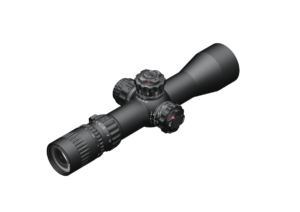S7, just to chime in with a consideration, just looking at the magnification and objective lens — maybe to narrow things down — maybe to muddle the waters again.....
 (No. 1) March Compact 2.5-25x42
(No. 1) March Compact 2.5-25x42
(No. 2) March Compact 2.5-25x52 [corrected]
(No. 3) March FX 1.5-15x42
 (A)
(A) Without knowing your shooting scenarios: Do you really need such a wide FoV as a 1.5x (No. 3)? Even 2.5x (No. 1 and 2) seem pretty wide by most shooting scenarios (it seems that only shooting scurrying rats at 10y range would call for such a wide FoV).
With a 3x you might have all the FoV you'll need.
 (B)
(B) For FFP scopes only: The wider the magnification range the smaller the reticle when on lower magnification.
•All three scopes, No. 1, 2, and 3, have a 10-fold magnification range.
10-fold is fairly "extreme".
For comparison, typical magnification ranges are:
•6-24x and 4-16x have a 4-fold magni range.
•5-30x and 4-24x and 4.5-27x have a 6-fold magni range.
•2.5-20x and 3-24x and have an 8-fold magni range.
 (C)
(C) The larger the objective lens, the narrower the SPR (the
sharpness and
parallax
range, in photography also called the DoF = depth of field). (cf. attachment below).
A narrow SPR means that for example, at a given parallax setting objects/quarry/windflags are
in focus from 15y to 20y.
Whereas a wider SPR means they are
in focus from 13y to 24y, for example.
Also: The higher the magnification in use, the narrower the SPR.
➔ Important for hunting critters that move a lot.
Your No. 2 has a larger objective lens than No. 1 and No. 3.
 (D)
(D) Your No. 1 and No. 2 have 25x top end magnification — your No. 3 only 15x.
In 15x the image of your quarry and it's killzone is aprox. 50% smaller than in 25x.
The adage "Aim small — miss small" is a good one.
For offhand shooting you won't be needing 25x. But for rested longer ranges you might want this.
I haven't heard anybody complain about having a scope with a magnification range that goes higher than needed at the time. But I HAVE heard many complain about not having enough magnification at the time when it was needed.
 (E)
(E) Your No. 2 has a larger objective lens that will permit more light (assuming all other factors being equal).
If you plan on filming through your scope, especially filming in slo-motion, you do need lots and lots of light.
Hope I didn't muddle the waters.....

Matthias

Attachment:
SCOPE Triangle #2 – to Balance High Magnification + Depth of Field (for Less Parallax) + Brightness
As PDF File: View attachment SCOPE Triangle 2 – to Balance High Magnification + Depth of Field (for Less Parallax) + Bright...pdf 



